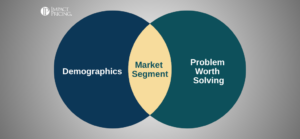Customer lifetime value refers to how much value (or revenue) we could earn from a customer over the duration of their time with us as a customer. So long as it’s profitable to do so, a business should prioritize deepening and lengthening this metric. So, how do you price to maximize the lifetime value of a customer? It’s an interesting question. In its simplest form, the issue comes down to customer capture and customer retention.
Customer Capture and Retention for Maximum Lifetime Value
What does it take to capture a new customer? Of course, when we price a product we aren’t guaranteed to always make the sale. In general, the lower we price a product, the higher the probability the customer will buy it. If it is a one-time purchase (meaning selling this one doesn’t make it more likely to sell the next one to the same customer), then we would simply choose the profit maximizing price.
However, if we believe that capturing a customer makes it more likely to sell another product later, to the same customer, then it may be in our benefit to lower our price so we can win more customers up front. We often see special rates to new subscribers for satellite TV services, or cell phone services. Within these industries, they can determine if you are a new customer or not. And once they have you, they really lock you in (for years). As well as low prices, we also see products sometimes offered for free in order to capture new customers. For example, free samples of products or free trial periods of software. The more likely you are to sell another unit to the same customer (if you’ve already sold them one), the lower you can set your customer capture price.
Other customer retention prices work the same way, only they are slightly higher. Companies who price this way recognize they have some “loyalty”, meaning the customer is predisposed to purchase their product over their competitors. This way, a company can charge a higher price than they would if the customer were making a first-time decision. After all, you should be able to capture customers’ loyalty. When you set a customer retention price, some customers will buy and some won’t. You may be tempted to select the profit maximizing price for this decision.
But note that you are in a similar position as you were when setting the customer capture price. If you win a customer, you may have a higher probability of winning them again. This gives you extra incentive to lose fewer customers, motivating you to price lower than your profit maximizing price. This price of course is going to be higher than the customer capture price, but not as high as it would be if you knew this is the last this customer will purchase from you (or give you loyalty).
What if you could segment loyal customers from those that make stand-alone decisions every time?
The above logic implies you may want to give your loyal customers lower prices, because this can keep them coming back. Restaurants like Subway offer a ‘buy 10 get 1 free’ card to do exactly that. They offer their loyal customers a 10% discount (actually 9% – but who’s counting?) while the non-loyal customers pay full price.
The real answer though is, it depends. It’s quite possible the loyalty is so high that you may be able to charge an exorbitant price to most of your repeat customers, while losing only a few. In this case, you would charge them more than a non-loyal customer if possible. Yet I can only think of three scenarios where you could get away with this:
- The customer is ignorant of other prices, and just continues writing the check.
- The customer is somehow locked into the deal, like a cell phone contract.
- The customer faces high switching costs (similar to 2), presenting resistance to changing products.
In the absence of one of those three conditions, you should set your loyal customer price lower than (or equal to) your non-loyal customer price.
Summary – Without going through any complex math, our observations tell us two things: first, charge a lower capture price for customers who are likely to make a repeat purchase; and second, for repeat purchases, charge more than the capture price, but less than what you’d charge a non-loyal customer.















